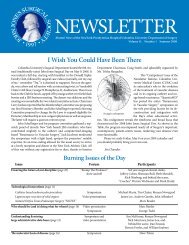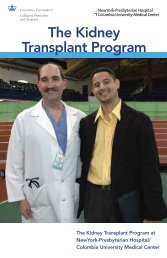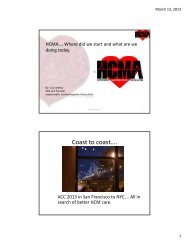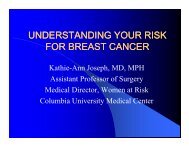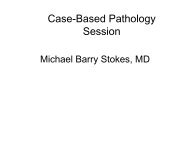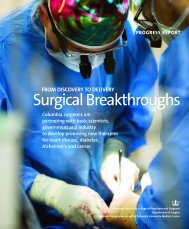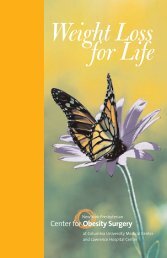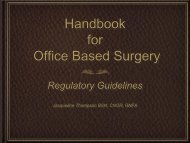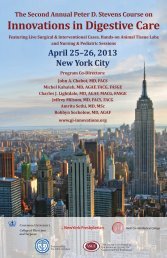NEWSLETTER - Columbia University Department of Surgery
NEWSLETTER - Columbia University Department of Surgery
NEWSLETTER - Columbia University Department of Surgery
Create successful ePaper yourself
Turn your PDF publications into a flip-book with our unique Google optimized e-Paper software.
ter the birth <strong>of</strong> their twin sons in 1938, just 4 years after they were<br />
married, leaving Jerome with their first born daughter and two baby<br />
boys. Within a year he had engaged trustworthy caretakers and servants<br />
to allow him to work long hours at the hospital and return<br />
to his civic and social activities. Geraldine Webster had studied the<br />
Montessori Method herself and engaged a nursery school teacher for<br />
her two-year old daughter that evolved into a Montessori nursery<br />
school for all three children and those <strong>of</strong> Webster’s P&S colleagues<br />
and friends. He had sufficient confidence in his “home staff” to accept<br />
the nights away, inherent in his accepting Trustee appointments<br />
at both Trinity College and the Holderness school, and continuing<br />
in both positions until 1960.<br />
He entertained frequently and from about 1943 to 1957, hosted<br />
an annual June “Holderness Frolic,” bringing current Holderness<br />
students and alumni together at his Riverdale home, overlooking<br />
the Hudson. The boys were 12 when Jerome married Emily Brune<br />
Randall in 1951. She proved to be a good companion for him but<br />
integrating into a family accustomed to relating to servants and an<br />
<strong>of</strong>ten away father was not an easy process for all participants.<br />
Webster Family’s 1958 Christmas Card: front row, Jerome, Emily, and Hartley<br />
Webster; rear row, Dine and Bob Dellenback and Jay (JP Jr.) Webster (The<br />
Chesapeake Bay Retrievers are L→R, littermates Taffy and Fudge and their<br />
<strong>of</strong>fspring, “Pupnik,” whose birth coincided with Sputnik’s Oct 4, 1957 launch.)<br />
Webster gave the commencement address to Jay and Hartley<br />
Webster’s Holderness Class <strong>of</strong> 1957, which exhibits humility and<br />
begins and ends with an allusion to the teachings <strong>of</strong> his church.<br />
On such a perfect day as this, I like to think <strong>of</strong> the second<br />
verse <strong>of</strong> the 29th Psalm and wish to change it from “Worship<br />
the Lord in the beauty <strong>of</strong> holiness” to “in the beauty <strong>of</strong><br />
Holderness…it was my home for 30 years as son <strong>of</strong> its headmaster,<br />
my school for six years… for many years I have been<br />
a Trustee, and for four years I have been a parent <strong>of</strong> two <strong>of</strong><br />
its students… Thank you Mr. [Headmaster]… for the opportunity<br />
to express my sentiments in this, my maiden commencement<br />
address.<br />
Now let me [conclude] with the words <strong>of</strong> a man who<br />
spent five years in prison, <strong>of</strong>ten in chains, 1900 years ago:<br />
“And this I pray, that your love may abound yet more and<br />
more in knowledge and in all judgment.” (Philippians I:9…)<br />
Emily died in 1965. Webster’s sister, Bobbie, who favored her<br />
second given name as an adult, outside <strong>of</strong> the family, married William<br />
Starr and became a noted miniaturist as Lorraine Starr, sug-<br />
John Jones Surgical Society Volume 13, Number 2 Winter 2010<br />
gesting a family trait for fine motor skills. Lorraine died in 1966<br />
from complications following multiple fractures and a closed head<br />
injury, sustained as a right front seat passenger in an automobile<br />
crash. Harold Webster always remained in the Plymouth NH area<br />
and passed away in 1968.<br />
The Webster Library <strong>of</strong> Plastic <strong>Surgery</strong><br />
An upperclassman at the Johns Hopkins medical school (the<br />
snake in the Library’s Genesis) <strong>of</strong>fered to give Webster an entire<br />
medical library which was a legacy from his wealthy physician father.<br />
Webster declined the <strong>of</strong>fer, given the difficulties and expense<br />
<strong>of</strong> storing the collection for six or seven years during “the pursuit <strong>of</strong><br />
Medicine,” and after being told by the potential donor that only the<br />
latest books were <strong>of</strong> value. Ruminative regretting over those missed<br />
“gems and incunabula † ” and the personage <strong>of</strong> 16th century Gaspare<br />
Tagliacozzi afflicted Webster with a bibliomania that produced the<br />
world’s most comprehensive plastic surgery library.<br />
In 1929, Elizabeth Schramm, the Medical Center’s assistant<br />
medical librarian, (and the Eve in this story) introduced Webster to<br />
the “pleasurable but pocket-emptying delights <strong>of</strong> book catalogue perusal.”<br />
She directed his attention in particular to “an enticing item”<br />
for sale – a first folio edition <strong>of</strong> Gaspare Tagliacozzi’s 1597 classic, De<br />
Curtorum Chirurgia per Insitionem (The <strong>Surgery</strong> <strong>of</strong> Deformities by<br />
Transplantation), the first book published on plastic surgery (Fig. 7).<br />
The price was 50 pounds ($250), a substantial sum at the time, and he<br />
happily paid it. 19 Webster’s library would eventually hold seven copies<br />
<strong>of</strong> this 1597 printing, two copies <strong>of</strong> the extremely rare pirated edition<br />
<strong>of</strong> the same year, and three <strong>of</strong> the Frankfurt third edition <strong>of</strong> 1598.<br />
“The possession <strong>of</strong> a copy <strong>of</strong> this early monument in the specialty<br />
whetted not only my interest in the history <strong>of</strong> the subject, but<br />
also my desire to learn all I could about the life <strong>of</strong> this pioneer.” This<br />
provoked multiple transatlantic crossings and searching libraries in<br />
Copenhagen, Berlin, Leipzig, Bologna, Paris, and London for information<br />
about Tagliacozzi and early reconstructive and tissue transferring<br />
procedures. Webster was in Europe in 1931 when he discovered<br />
a description <strong>of</strong> the earliest known methods for transferring<br />
full thickness flaps from one lip to the other. He also had a chance to<br />
chat with P&S alumnus William H. Welch, who was nearing the end<br />
<strong>of</strong> his reign as the most influential physician in America. 20 Welch<br />
was collecting books for a new Hopkins library named in his honor.<br />
On his next trip in 1932, Berlin bookseller, Oscar Rothacker was <strong>of</strong>fering<br />
the combined libraries <strong>of</strong> two recently deceased plastic surgeons,<br />
comprising thousands <strong>of</strong> books and theses relating at least in<br />
part to plastic surgery. Rothacker’s asking price was astronomical,<br />
and another bidder was involved, so Webster cabled Whipple for an<br />
advance from the Plastic <strong>Surgery</strong> Fund and sealed the deal.<br />
The Rothacker purchase filled two <strong>of</strong> the three rooms beneath<br />
the McCosh surgical amphitheater. 21 Webster found that it included<br />
two extremely rare volumes in mint condition – Argellata’s Chirurgia,<br />
1497, and Nicolaus Falcutius’ Sermones medicinales, 1490-91. He<br />
also spotted an 1863 bibliography compiled by Eduard Zeis, entitled<br />
Die Literature und Geschichte der Plastischen Chirurgie (The literature<br />
and history <strong>of</strong> Plastic <strong>Surgery</strong>), which launched another search<br />
to obtain all <strong>of</strong> its listings.<br />
When Webster died in 1974, his library held more than 5,500<br />
books dating from 1490 into the 20th century, several thousand<br />
medical school dissertations, and at least 29,000 reprints. Besides<br />
the seven copies <strong>of</strong> De Curtorum Chirurgia, the library includes<br />
books by or about Tagliacozzi’s colleagues; histories <strong>of</strong> Bologna and<br />
†Books published before 1501 or early artifacts The American Heritage College Dictionary, 3rd edition. Boston: Houghton Mifflin Co. 1992<br />
17



